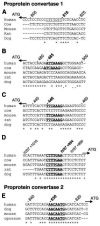TCF7L2 polymorphisms modulate proinsulin levels and beta-cell function in a British Europid population
- PMID: 17416797
- PMCID: PMC2668957
- DOI: 10.2337/db07-0055
TCF7L2 polymorphisms modulate proinsulin levels and beta-cell function in a British Europid population
Abstract
Rapidly accumulating evidence shows that common T-cell transcription factor (TCF)7L2 polymorphisms confer risk of type 2 diabetes through unknown mechanisms. We examined the association between four TCF7L2 single nucleotide polymorphisms (SNPs), including rs7903146, and measures of insulin sensitivity and insulin secretion in 1,697 Europid men and women of the population-based MRC (Medical Research Council)-Ely study. The T-(minor) allele of rs7903146 was strongly and positively associated with fasting proinsulin (P = 4.55 x 10(-9)) and 32,33 split proinsulin (P = 1.72 x 10(-4)) relative to total insulin levels; i.e., differences between T/T and C/C homozygotes amounted to 21.9 and 18.4% respectively. Notably, the insulin-to-glucose ratio (IGR) at 30-min oral glucose tolerance test (OGTT), a frequently used surrogate of first-phase insulin secretion, was not associated with the TCF7L2 SNP (P > 0.7). However, the insulin response (IGR) at 60-min OGTT was significantly lower in T-allele carriers (P = 3.5 x 10(-3)). The T-allele was also associated with higher A1C concentrations (P = 1.2 x 10(-2)) and reduced beta-cell function, assessed by homeostasis model assessment of beta-cell function (P = 2.8 x 10(-2)). Similar results were obtained for the other TCF7L2 SNPs. Of note, both major genes involved in proinsulin processing (PC1, PC2) contain TCF-binding sites in their promoters. Our findings suggest that the TCF7L2 risk allele may predispose to type 2 diabetes by impairing beta-cell proinsulin processing. The risk allele increases proinsulin levels and diminishes the 60-min but not 30-min insulin response during OGTT. The strong association between the TCF7L2 risk allele and fasting proinsulin but not insulin levels is notable, as, in this unselected and largely normoglycemic population, external influences on beta-cell stress are unlikely to be major factors influencing the efficiency of proinsulin processing.
Figures


Similar articles
-
Association of variants of the TCF7L2 gene with increases in the risk of type 2 diabetes and the proinsulin:insulin ratio in the Spanish population.Diabetologia. 2008 Nov;51(11):1993-7. doi: 10.1007/s00125-008-1129-2. Epub 2008 Aug 19. Diabetologia. 2008. PMID: 18712344
-
TCF7L2 variants are associated with increased proinsulin/insulin ratios but not obesity traits in the Framingham Heart Study.Diabetologia. 2009 Apr;52(4):614-20. doi: 10.1007/s00125-009-1266-2. Epub 2009 Jan 31. Diabetologia. 2009. PMID: 19183934 Free PMC article.
-
Variants of the TCF7L2 gene are associated with beta cell dysfunction and confer an increased risk of type 2 diabetes mellitus in the ULSAM cohort of Swedish elderly men.Diabetologia. 2007 Sep;50(9):1852. doi: 10.1007/s00125-007-0746-5. Epub 2007 Jul 6. Diabetologia. 2007. PMID: 17618413
-
TCF7L2 genetic defect and type 2 diabetes.Curr Diab Rep. 2008 Apr;8(2):149-55. doi: 10.1007/s11892-008-0026-x. Curr Diab Rep. 2008. PMID: 18445358 Review.
-
Association between TCF7L2 gene polymorphisms and susceptibility to type 2 diabetes mellitus: a large Human Genome Epidemiology (HuGE) review and meta-analysis.BMC Med Genet. 2009 Feb 19;10:15. doi: 10.1186/1471-2350-10-15. BMC Med Genet. 2009. PMID: 19228405 Free PMC article. Review.
Cited by
-
Serotonin is elevated in risk-genotype carriers of TCF7L2 - rs7903146.Sci Rep. 2019 Sep 6;9(1):12863. doi: 10.1038/s41598-019-49347-y. Sci Rep. 2019. PMID: 31492908 Free PMC article.
-
Genomics of type 2 diabetes mellitus: implications for the clinician.Nat Rev Endocrinol. 2009 Aug;5(8):429-36. doi: 10.1038/nrendo.2009.129. Epub 2009 Jun 30. Nat Rev Endocrinol. 2009. PMID: 19564886 Review.
-
In vivo misfolding of proinsulin below the threshold of frank diabetes.Diabetes. 2011 Aug;60(8):2092-101. doi: 10.2337/db10-1671. Epub 2011 Jun 15. Diabetes. 2011. PMID: 21677281 Free PMC article.
-
Beta cell glucose sensitivity is decreased by 39% in non-diabetic individuals carrying multiple diabetes-risk alleles compared with those with no risk alleles.Diabetologia. 2008 Nov;51(11):1989-92. doi: 10.1007/s00125-008-1124-7. Epub 2008 Aug 22. Diabetologia. 2008. PMID: 18719881
-
Genetic modifiers of cystic fibrosis-related diabetes.Diabetes. 2013 Oct;62(10):3627-35. doi: 10.2337/db13-0510. Epub 2013 May 13. Diabetes. 2013. PMID: 23670970 Free PMC article.
References
-
- Grant SFA, Thorleifsson G, Reynisdottir I, Benediktsson R, Manolescu A, Sainz J, Helgason A, Stefansson H, Emilsson V, Helgadottir A, Styrkarsdottir U, Magnusson KP, Walters GB, Palsdottir E, Jonsdottir T, Gudmundsdottir T, Gylfason A, Saemundsdottir J, Wilensky RL, Reilly MP, Rader DJ, Bagger Y, Christiansen C, Gudnason V, Sigurdsson G, Thor-steinsdottir U, Gulcher JR, Kong A, Stefansson K. Variant of transcription factor 7-like 2 (TCF7L2) gene confers risk of type 2 diabetes. Nat Genet. 2006;38:320–323. - PubMed
-
- Saxena R, Gianniny L, Burtt NP, Lyssenko V, Giuducci C, Sjogren M, Florez JC, Almgren P, Isomaa B, Orho-Melander M, Lindblad U, Daly MJ, Tuomi T, Hirschhorn JN, Ardlie KG, Groop LC, Altshuler D. Common single nucleotide polymorphisms in TCF7L2 are reproducibly associated with type 2 diabetes and reduce the insulin response to glucose in nondiabetic individuals. Diabetes. 2006;55:2890–2895. - PubMed
-
- van Vliet-Ostaptchouk JV, Shiri-Sverdlov R, Zhernakova A, Strengman E, van Haeften TW, Hofker MH, Wijmenga C. Association of variants of transcription factor 7-like 2 (TCF7L2) with susceptibility to type 2 diabetes in the Dutch Breda cohort. Diabetologia. 2006;50:59–62. - PubMed
-
- Damcott CM, Pollin TI, Reinhart LJ, Ott SH, Shen H, Silver KD, Mitchell BD, Shuldiner AR. Polymorphisms in the transcription factor 7-like 2 (TCF7L2) gene are associated with type 2 diabetes in the Amish: replication and evidence for a role in both insulin secretion and insulin resistance. Diabetes. 2006;55:2654–2659. - PubMed
Publication types
MeSH terms
Substances
Grants and funding
LinkOut - more resources
Full Text Sources
Medical
Research Materials
Miscellaneous

